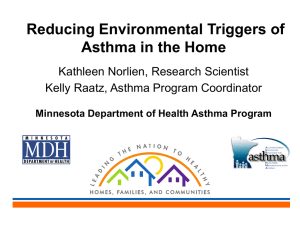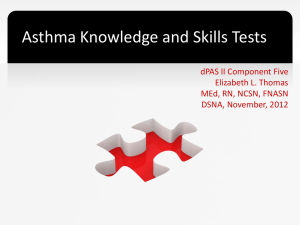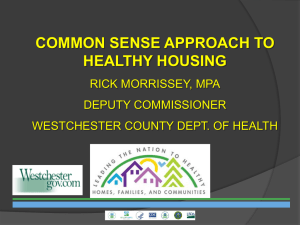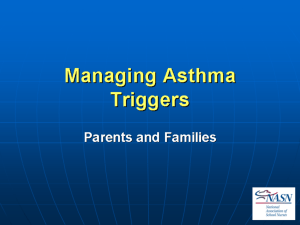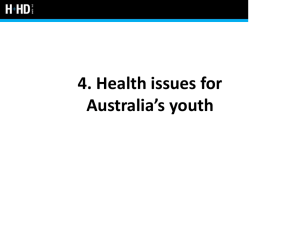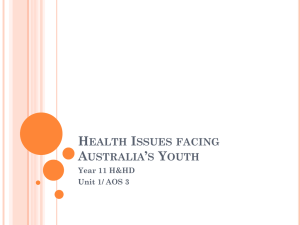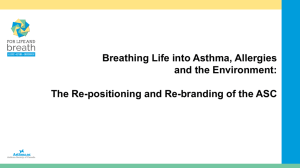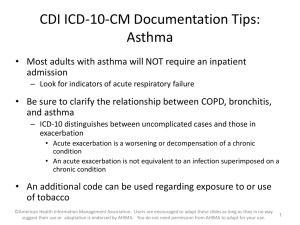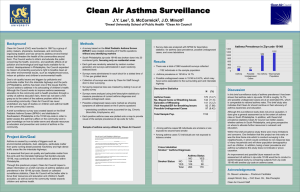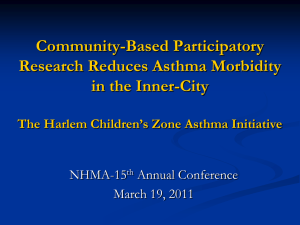Presentation 1 - National Healthy Homes Conference
advertisement
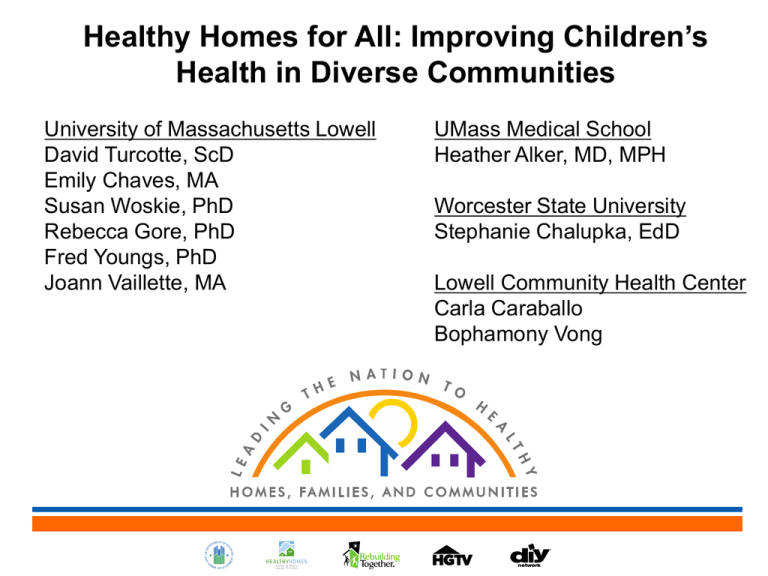
Healthy Homes for All: Improving Children’s Health in Diverse Communities University of Massachusetts Lowell David Turcotte, ScD Emily Chaves, MA Susan Woskie, PhD Rebecca Gore, PhD Fred Youngs, PhD Joann Vaillette, MA UMass Medical School Heather Alker, MD, MPH Worcester State University Stephanie Chalupka, EdD Lowell Community Health Center Carla Caraballo Bophamony Vong Presenter Disclosures David Turcotte, ScD Joann Vaillette, MA Emily Chaves, MA Susan Woskie, PhD Rebecca Gore, PhD Fred Youngs, PhD Heather Alker, MD, MPH Carla Caraballo Bophamony Vong “No relationships to disclose” Funded by the U.S. Department of Housing and Urban Development Why asthma? Why Lowell? – – – – High asthma rate Diverse community Poor housing stock Community health partners • U.S. Asthma Rates – General Population 8.2% – Puerto Rican 16.6% (National Health Statistics report on asthma prevalence in the United States, 2011) • Hospitalization rates for asthmatic children age 0-4 – Massachusetts 430 per 100,000 – Lowell 805 per 100,000 (Asthma report for Lowell mortality and hospital data. Massachusetts DPH, 2007-2009) Project Goals: Families Home assessments Home interventions Education First time home buyers Education Partners Education Partners & Roles • • • • • • University of Massachusetts Lowell Lowell Community Health Center Coalition for a Better Acre Community Teamwork, Inc. Lowell Housing Authority Merrimack Valley Housing Partnership Families – who are they? • Live in Lowell, MA • Have at least one child with asthma (<=14) • Low-moderate income • 165 families enrolled (245 children) What is Asthma? • A serious & sometimes life-threatening respiratory disease • Affects the quality of life for millions of Americans • No cure for Asthma yet • Can be controlled through medical treatment & management of environmental triggers Indoor Environment and Asthma •Americans spend up to 90% of their time indoors •Indoor concentrations of most pollutants are higher than outdoor Indoor Environment and Asthma • Indoor allergens and irritants can play significant roles in triggering asthma attacks – Ex: pet dander, mice, cockroaches, dust mites, harsh chemicals, fragrances, smoke, moisture/mold, pollen • Important to recognize potential asthma triggers & reduce exposure Home Intervention - Assessment • Health/environmental assessments – – – – Health questionnaire with parent Environmental walk-through assessment Environmental questionnaire with parent Dust sampling Assessment Education, Supplies, Remediation Mid-term Assessment Final Assessment 6th month 12th month Education, Supplies, Remediation Based on findings from assessment: • Education • Supplies – Dust mites and healthy cleaning practices – Pets – Avoiding pests – Moisture/mold control – Smoking – Air pollution (indoor & outdoor) – Safety Assessment Education, Supplies, Remediation – HEPA vacuum – Allergen-proof mattress and pillow covers – Trash can with lid – Food containers – Non-toxic cleaner – Baits and traps for pests – Safety items Mid-term Final Assessment Assessment 6th month 12th month Education, Supplies, Remediation Cont. • Remediation – – – – Carpet removal Install ventilation Integrated Pest Management (IPM) Industrial cleaning Assessment Education, Supplies, Remediation Mid-term Assessment Final Assessment 6th month 12th month Mid-term Assessment • • • • Health questionnaire (abbreviated) Environmental questionnaire (abbreviated) More supplies if needed Reinforce education Assessment Education, Supplies, Remediation Mid-term Assessment Final Assessment 6th month 12th month Final Assessment • • • • Health questionnaire Environmental questionnaire Environmental walk-through Gift certificate Assessment Education, Supplies, Remediation Mid-term Assessment Final Assessment 6th month 12th month Accomplishments • Conducted 178 home assessments • Completed 160 interventions • Evaluation of intervention effectiveness (midterms & final assessments) • Trained 75 partner staff in HH practices • Provided HH education to 1,537 community members Results Table 1. Demographics of participants Children not completing study (n=75) Respondent: Parent Respondent gender: Female Child race/ethnicity Black/African American White/Caucasian* Asian/Oriental Spanish/Hispanic Other Child gender: Male Children completing study (n=170) 90.7 94.7 94.7 95.9 6.7 4 10.7 57.3 21.3 54.7 4.7 12.4 15.3 52.9 14.7 59.4 Table 1. Demographics of participants (Cont.) Children not completing study (n=75) Parent marital status: Married Mother’s education: Any college Father’s education: Any college Household income: 0-50% AMI Smoker in primary home High risk asthma group Child age (mean) 12 27 25.6 90.7 13.3 44 5.97 Children completing study (n=170) 22.4 33.3 20.2 84.7 16.5 38.2 6.08 Housing conditions at baseline – Outdoor sources of pollution Within ½ mile of home Gas Station City Bus Stop % (n=114) 89 88 Restaurant Dry Cleaner Auto Body Shop 86 65 58 Truck Loading Area Bakery Other 46 43 25 Furniture Refinisher 5 Trucks drive on street Often – 42% Occ. – 25% Change in housing conditions Reported pest activity in past month Baseline % Final % Rodents 29 16.5 Cockroaches* 30 18 Change in housing conditions Flooring type in child’s Baseline % bedroom (n=170) Final % (n=170) Wall-to-wall carpet Area rug* Throw rugs* 58 6.5 2 56 1.8 0 Hard floors 35 42 Changes in housing conditions - Mold Baseline % Final % (n=115) (n=114) Any surfaces with mold/mildew 40 32 Change in Asthma Trigger Activities Baseline % Air freshener used most days* 62 Candle/incense used most days* 29 Final % 31.5 15 Cleaning chemical use Only “Green” cleaners used* Some “Green” cleaners used* 85 1 8 76 27 46 Own HEPA vacuum cleaner* Mattress and pillow covers* Wash linens in hot water* 9 0 66 98 96 89 Dry linens with hot air* 98 100 Health Results – Asthma Severity Baseline Final Average Average Wheezing # of times child experienced wheezing in the past 4 weeks Asthma Attacks # of times child had asthma attack or trouble breathing in the past 4 weeks Doctor Visits # of times child went to doctor office or clinic for asthma problems in the past 4 weeks Emergency Room/ Hospital Visits # of emergency room or hospital visits due to asthma in the past 4 weeks n=170 Percent Change 6.4 2.3 -65% 0.8 0.2 -76% 0.7 0.2 -64% 0.2 0.04 -79% Health Results – Change in CHSA Scores Baseline Mean 66.8 84.9 88.7 67.9 Final Mean 89.3 93.0 97.4 88.0 Physical Health Activity Child Activity Family Emotional Health Child Emotional Health 71.2 81.1 Family n=170 (scores range from 0-100) Change (paired values) 23.3 8.4 8.7 20.5 9.9 Health Results – Med use • Reduced use of asthma medication (Reported use in prior 4 weeks) • Baseline: 145 of 164 using meds (88%) • Final: 101 of 164 using meds (62%) Cost Savings from Health Outcome Improvements Urgent Care Per Decrease 4-week recall 6 month 12 month Usage in Occurr- period (~1 savings* savings* Cost ence ** ** month savings) 8 39,376 236,256 472,512 Hospitalization 4,922 * 834 29 24,186 145,116 290,232 Emergency Room* Doctor Visits** 100 76 7,600 45,600 91,200 Decrease in Costs 71,162 426,972 853,944 Intervention Cost 32,640 32,640 32,640 Net Savings $38,522 $394,332 $821,304 *The hospitalization and ER data was provided by the MA Department of Public Health assessment of average charges in Lowell in 2010 due to usage because of asthma. **The $100 per doctor visits is an estimated average cost based on discussions with local doctors’ offices. Which components of our interventions had the biggest impact on health outcomes? • No component was associated with health improvements on its own • Asthma Trigger indices: – Allergen Risk Index – Chemical Risk Index – Cleaning Risk Index – No statistically significant associations • Conclusion: Single-component interventions or interventions of smaller scope may not result in positive health outcomes for asthmatics. Allergen Risk Index • Any pet • Pet in bedroom • Rug Chemical Risk Index (wall to wall or area) • Use air freshener • Mold • Use candles • Rodents • Use cleaning chem. most days • Cockroach • Used pesticides in past • Feather bedding month • No allergen pillow cover • Smoking • No allergen mattress • Professional rug cover cleaning* • Gas stove* Cleaning Risk Index • Infrequent dusting in child’s room • Infrequent mopping in child’s room • Wash linens • Does not wash linens in hot water • Does not dry linens with hot air • Food debris in kitchen* Conclusions • Prevalence of Environmental Asthma Triggers • Multi-trigger, multi-component interventions improve health and emotional well-being • Decrease in healthcare utilization & medication use • Incentive for medical providers/insurers to fund interventions • Importance of lay community health outreach workers • Involve key stakeholders to increase impact • Research needed on optimal intervention design to maximize ROI Contact Information David Turcotte, Sc.D. University of Massachusetts Lowell Email: David_Turcotte@uml.edu Telephone: (978) 934-4682 Emily Chaves, M.A. University of Massachusetts Lowell Email: Emily_Vidrine@uml.edu Telephone: (978) 934-4778


